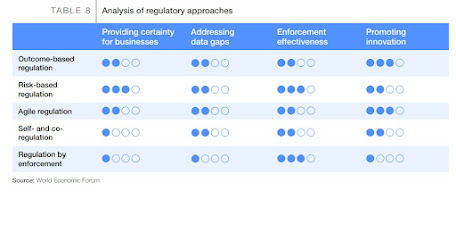World Economic Forum calls UAE crypto regulatory framework as agile and benefiting innovation
World Economic Forum report entitled “ Pathways to the Regulation of Crypto-Assets” says UAE crypto asset regulatory framework is an agile one, defining it as flexible, iterative and proactive which is beneficial because it is flexible, appreciate market maturity and ecosystem development.
According to the
WEF report, regulators that fall under this model include the Swiss Financial
Market Supervisory Authority. FINMA’s token classification prescribes three
simple categories: payment tokens, utility tokens and asset tokens. The
framework acknowledges hybrid tokens and that a token’s classification may
change over time. Following the first classification, FINMA later also
published further guidance in
Also included as
per the report are the regulatory sandboxes in the EU and India in addition to the UAE.
Instead of
prescribing and enforcing rules, agile regulation adopts a responsive,
iterative approach, acknowledging that policy and regulatory development is no
longer limited to governments but is increasingly a multi-stakeholder effort. Yet it also faces challenges that include the need for coordination and
collaboration being as well plagued with uncertainty.
Regulatory
sandboxes, guidance and regulators’ no-objection letters are all forms of agile
regulation that enable the testing of new types of solutions, iterating policy
frameworks based on ecosystem evolution and industry needs.
The report sets
out to understand and highlight the needs and challenges in developing a global
approach to crypto-asset regulation. In doing so, it delves into the various
regulatory approaches being adopted by different jurisdictions.
The report
developed rankings for each regulatory framework. The rankings covered four
areas when analyzing regulatory frameworks and found that the agile regulatory framework
is best at promoting innovation. Agile regulatory framework ranks in the middle
ground for providing certainty for businesses, addressing data gaps and enforcement
effectiveness.
The report finds
for example that Regulation by enforcement which the USA falls under is weak in
all the above mentioned areas except for enforcement effectiveness.
As per the
report the UAE has not only initiated a license regime for crypto assets, but
has also carried out consultation for decentralized applications such as DeFi,
and DAOs.
In addition the
report mentions that few jurisdictions have chosen to address the difficulty of
classifying tokens, partially relying instead on the functionality enabled by
the token.
For example,
Liechtenstein has chosen not to rely solely on classifications but to introduce
the token as such as an element in Liechtenstein Law, meaning that the right or
asset represented in the token triggers the application of special laws (the
so-called “token container model”). This means that the tokenization as such
has no legal effect: if a financial instrument is tokenized, the financial
market laws are applicable if the activity is regulated, too; if a commodity is
tokenized, the laws for commodity trading might be applicable; and so on. For
new instruments, such as utility coins and virtual currencies, a new regulation
has to be defined.
While in the
UAE, the Virtual Assets Regulatory Authority in Dubai has put forth a framework
that is underpinned by overarching regulations and compulsory rulebooks, segregating
activities-based rulebooks to rapidly account for novel products, emerging
technologies, and new business models that require regulatory capture.
The paper’s findings
reinforce the urgent need for policymakers and regulators to collaborate with
industry and users to realize the benefits while addressing the risks involved.
Enforcement is still weak globally. For example in the context of AML
supervision of crypto-assets, a Bank for International Settlements (BIS) 2021
survey found that oversight remained nascent globally. As stated, “Although many
are at different stages, with some countries still finalizing applicable law
and policy and a small portion engaging in active supervision, by and large
effective enforcement measures remain a work in progress. The result is a
complex tapestry of enforcement trends as well as enforcement risks posed by
the cross-jurisdictional influence of crypto-assets.”
Even when it
comes to the FATF travel rule implementations are also limited. As noted in
FATF’s June 2022 targeted update report, interoperability across technical solutions
and across jurisdictions is still lacking.
WEF report as such notes that such fragmented
enforcement techniques will pose a challenge to the supervision and monitoring
of crypto-assets against regulations in the short term and may take many years
to standardize.
The report recommends
promoting a harmonized understanding of taxonomy/classification of crypto assets
and activities, set out best practices and baseline regulatory standards for
achieving the desired regulatory outcomes and encourage passportability of
entities and data sharing.
Building on this
foundational paper, the World Economic Forum’s Blockchain and Digital Assets team
will launch an initiative focused on evaluating the outcomes of different
regional approaches to regulation. This effort will convene public- and private-sector
leaders to reveal first-hand learning’s and the unintended consequences.
But not everyone
shares the WEF reports belief that International crypto regulations and
standards are possible. During the Qatar
Economic Forum this week, Peter Smith Co-Founder and CEO of Blockchain.com rejected
claims of a “United Nations” of crypto as inconceivable. He stated, “A global
system to regulate cryptocurrency is unlikely to exist.”
However, the
Blockchain chief recalled the recent EU passing of the world’s first
comprehensive package as a step forward in cautiously regulating the
cryptocurrency industry. In addition, Smith told Bloomberg that regulators that
express optimistic calls to crypto would promote development for the industry.
So whether a global harmonic set of crypto assets regulations are formulated or whether regional and national countries work to build their own, the growth of crypto assets cannot be curved by regulators.


Comments
Post a Comment